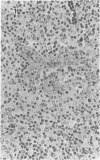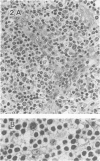Abstract
Biopsy specimens of lymph nodes with the histologic characteristics of angioimmunoblastic lymphadenopathy with dysproteinemia (AILD) were obtained from 9 cases (4 cases of AILD and 5 cases of AILD-like T lymphoma [AILD-T]) and histologically analyzed by the use of a double immunoenzymatic staining technique with the combination of a monoclonal antibody against lymphocyte membrane antigen and that against human DNA polymerase alpha (pol alpha), which is detectable in the nucleus of the cells in G1, S, and G2 phases. In all 9 cases, the pol alpha + proliferating cells had a peripheral T-cell phenotype with T11 and Leu-4 antigens, whereas proliferating B cells with B1 antigen were rarely observed. As for T-cell subset antigens, the proliferating T cells had T4+ helper/inducer phenotype in 7 cases, while T8+ suppressor/killer T cells proliferated in 2 cases, although a significant number of T4+ proliferating cells were also recognized. The study on malignant lymphomas that evolved in the 2 cases showed that the T-subset antigens on major proliferating tumor cells were the same as those found in the preceding AILD lesions, suggesting that lymphoma T cells originate from the AILD lesion. The results suggested that AILD without histologic manifestations of malignancy and AILD-T may be a neoplastic disease derived from either subset of peripheral T cells.
Full text
PDF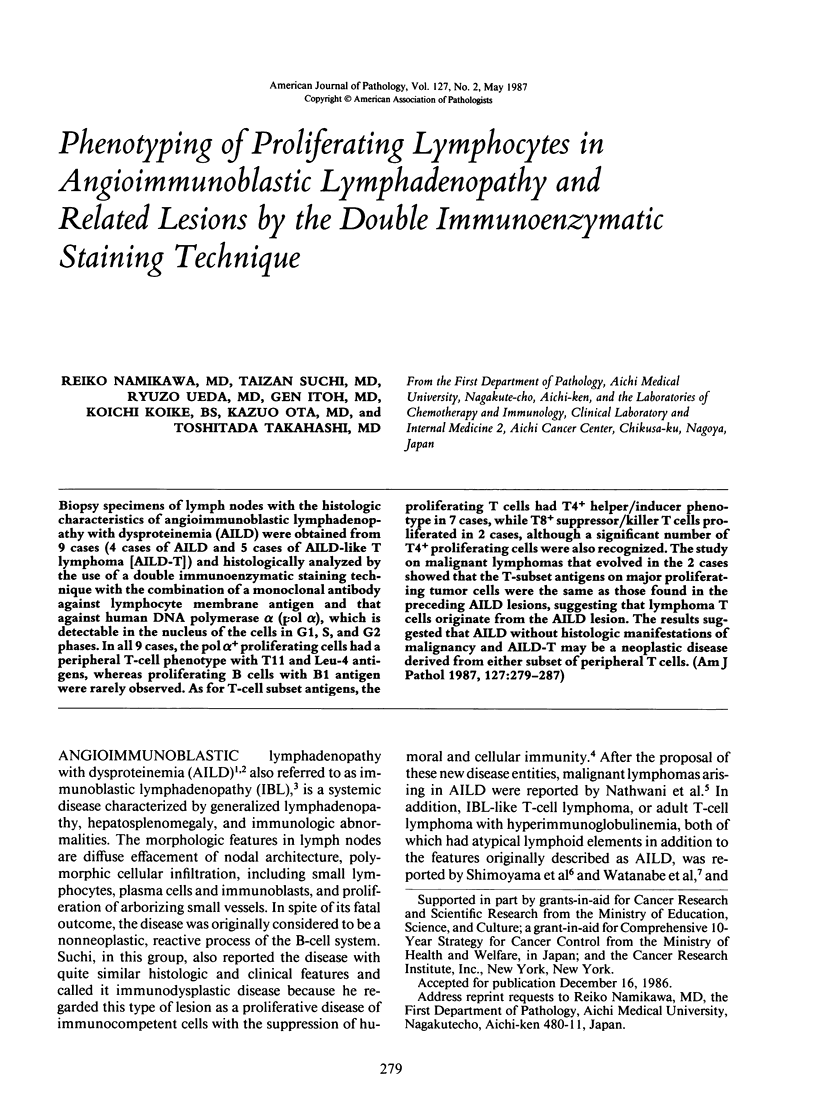
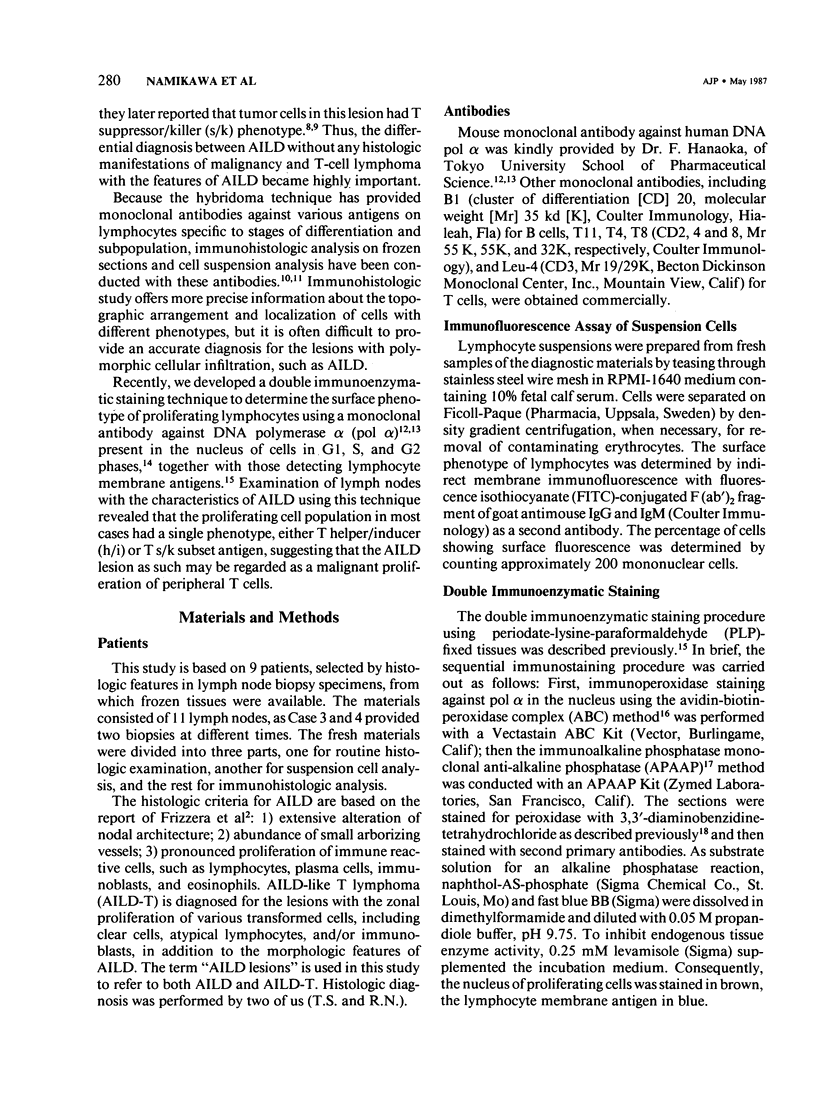
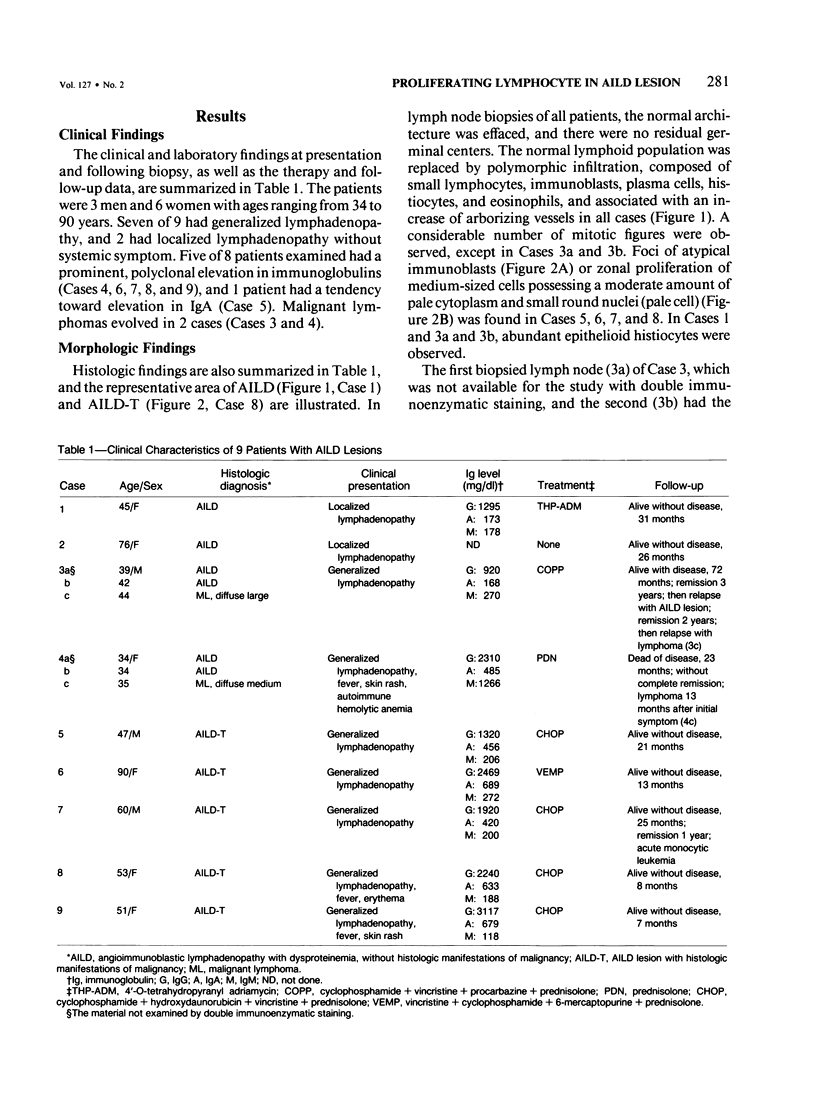

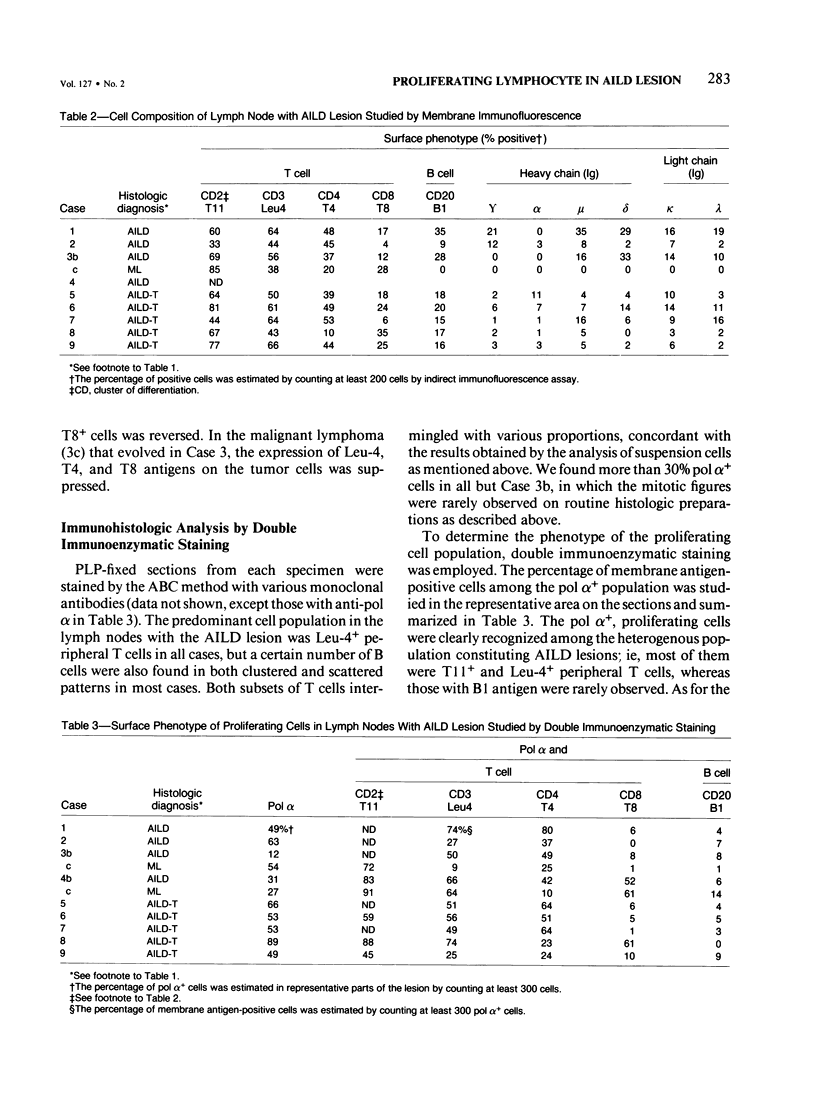
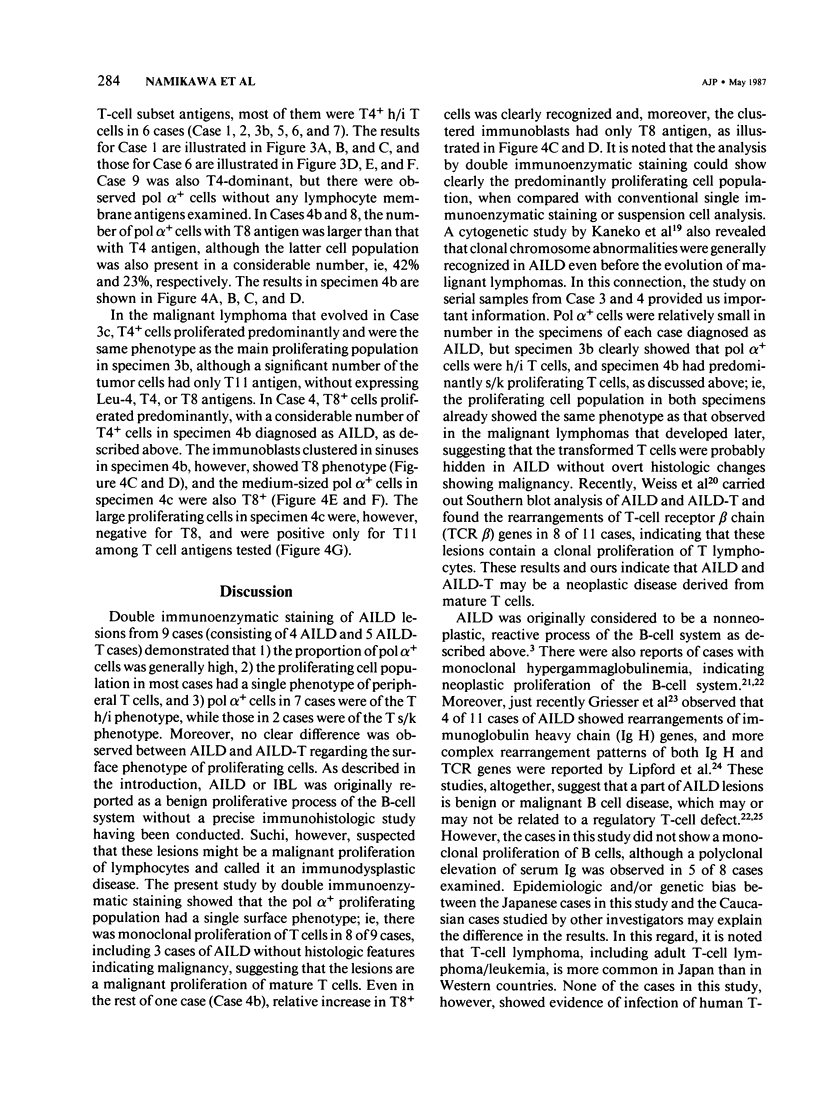
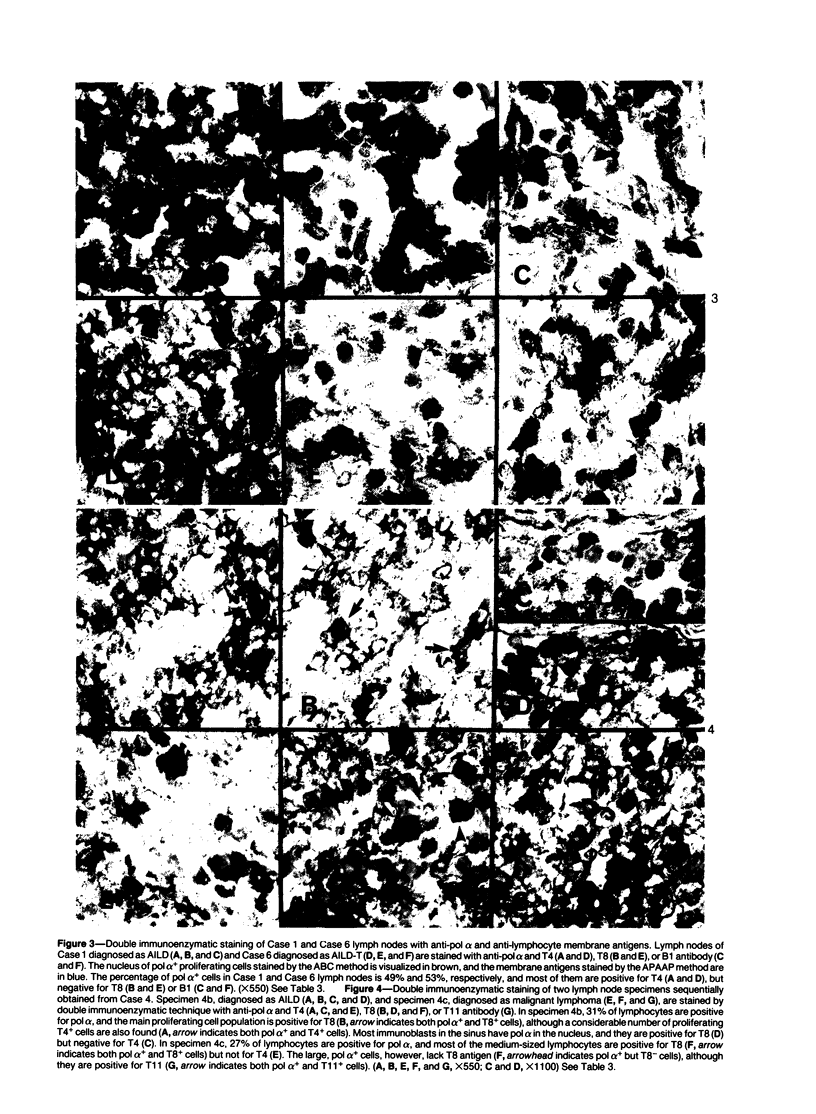
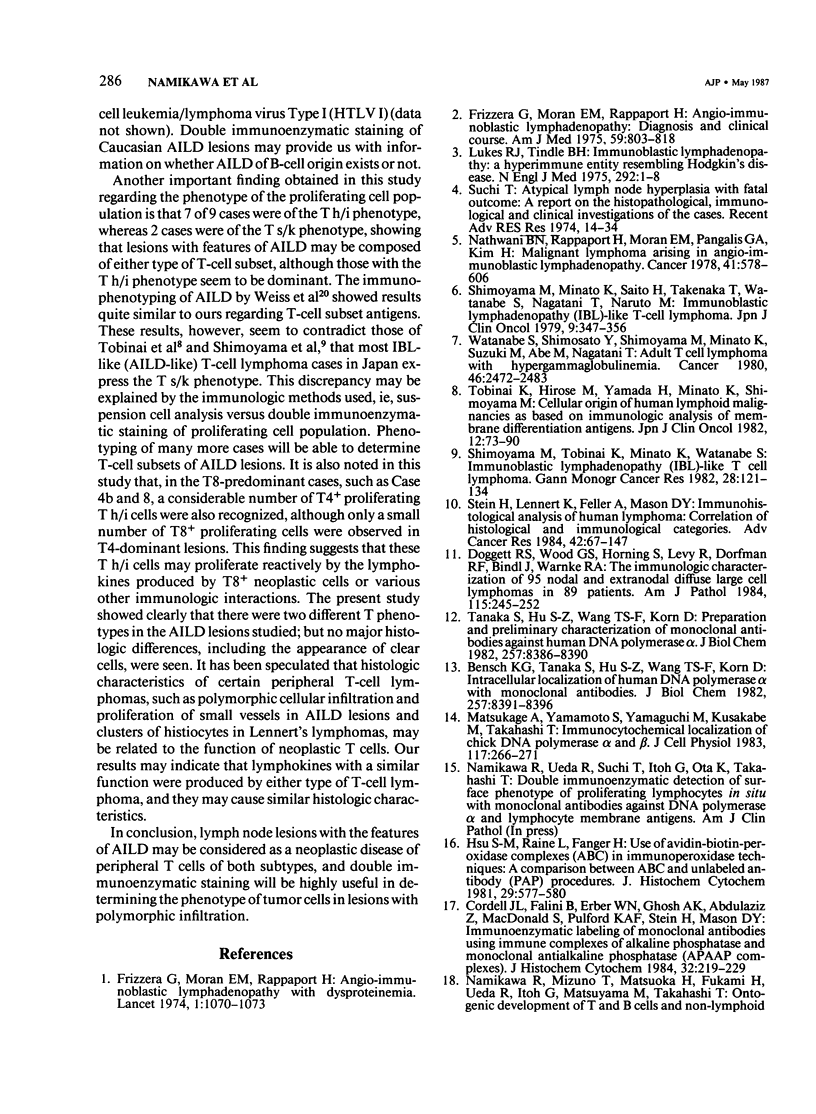
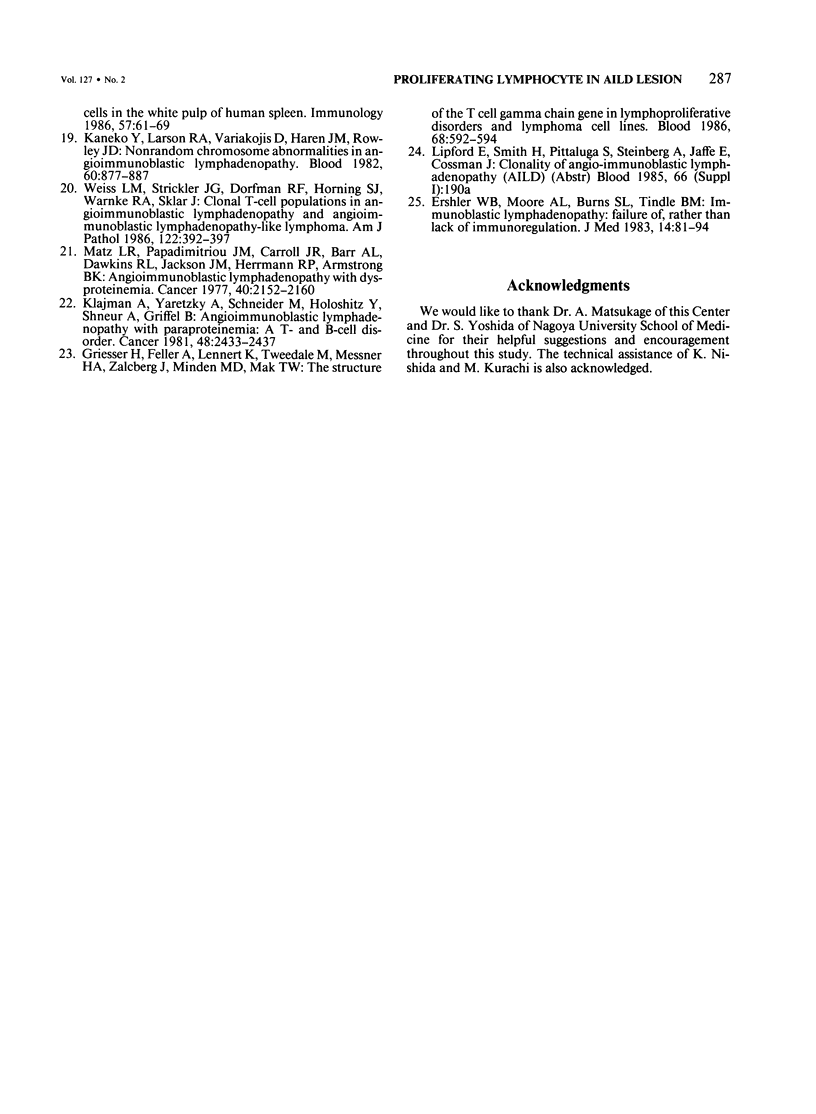
Images in this article
Selected References
These references are in PubMed. This may not be the complete list of references from this article.
- Bensch K. G., Tanaka S., Hu S. Z., Wang T. S., Korn D. Intracellular localization of human DNA polymerase alpha with monoclonal antibodies. J Biol Chem. 1982 Jul 25;257(14):8391–8396. [PubMed] [Google Scholar]
- Cordell J. L., Falini B., Erber W. N., Ghosh A. K., Abdulaziz Z., MacDonald S., Pulford K. A., Stein H., Mason D. Y. Immunoenzymatic labeling of monoclonal antibodies using immune complexes of alkaline phosphatase and monoclonal anti-alkaline phosphatase (APAAP complexes). J Histochem Cytochem. 1984 Feb;32(2):219–229. doi: 10.1177/32.2.6198355. [DOI] [PubMed] [Google Scholar]
- Doggett R. S., Wood G. S., Horning S., Levy R., Dorfman R. F., Bindl J., Warnke R. A. The immunologic characterization of 95 nodal and extranodal diffuse large cell lymphomas in 89 patients. Am J Pathol. 1984 May;115(2):245–252. [PMC free article] [PubMed] [Google Scholar]
- Ershler W. B., Moore A. L., Burns S. L., Tindle B. H. Immunoblastic lymphadenopathy: failure of, rather than lack of immunoregulation. J Med. 1983;14(2):81–94. [PubMed] [Google Scholar]
- Frizzera G., Moran E. M., Rappaport H. Angio-immunoblastic lymphadenopathy with dysproteinaemia. Lancet. 1974 Jun 1;1(7866):1070–1073. doi: 10.1016/s0140-6736(74)90553-4. [DOI] [PubMed] [Google Scholar]
- Frizzera G., Moran E. M., Rappaport H. Angio-immunoblastic lymphadenopathy. Diagnosis and clinical course. Am J Med. 1975 Dec;59(6):803–818. doi: 10.1016/0002-9343(75)90466-0. [DOI] [PubMed] [Google Scholar]
- Griesser H., Feller A., Lennert K., Tweedale M., Messner H. A., Zalcberg J., Minden M. D., Mak T. W. The structure of the T cell gamma chain gene in lymphoproliferative disorders and lymphoma cell lines. Blood. 1986 Aug;68(2):592–594. [PubMed] [Google Scholar]
- Hsu S. M., Raine L., Fanger H. Use of avidin-biotin-peroxidase complex (ABC) in immunoperoxidase techniques: a comparison between ABC and unlabeled antibody (PAP) procedures. J Histochem Cytochem. 1981 Apr;29(4):577–580. doi: 10.1177/29.4.6166661. [DOI] [PubMed] [Google Scholar]
- Kaneko Y., Larson R. A., Variakojis D., Haren J. M., Rowley J. D. Nonrandom chromosome abnormalities in angioimmunoblastic lymphadenopathy. Blood. 1982 Oct;60(4):877–887. [PubMed] [Google Scholar]
- Klajman A., Yaretzky A., Schneider M., Holoshitz Y., Shneur A., Griffel B. Angioimmunoblastic lymphadenopathy with paraproteinemia: a T- and B-cell disorder. Cancer. 1981 Dec 1;48(11):2433–2437. doi: 10.1002/1097-0142(19811201)48:11<2433::aid-cncr2820481116>3.0.co;2-u. [DOI] [PubMed] [Google Scholar]
- Lukes R. J., Tindle B. H. Immunoblastic lymphadenopathy. A hyperimmune entity resembling Hodgkin's disease. N Engl J Med. 1975 Jan 2;292(1):1–8. doi: 10.1056/NEJM197501022920101. [DOI] [PubMed] [Google Scholar]
- Matsukage A., Yamamoto S., Yamaguchi M., Kusakabe M., Takahashi T. Immunocytochemical localization of chick DNA polymerases alpha and beta +. J Cell Physiol. 1983 Nov;117(2):266–271. doi: 10.1002/jcp.1041170219. [DOI] [PubMed] [Google Scholar]
- Matz L. R., Papadimitriou J. M., Carroll J. R., Barr A. L., Dawkins R. L., Jackson J. M., Herrmann R. P., Armstrong B. K. Angioimmunoblastic lymphadenopathy with dysproteinemia. Cancer. 1977 Nov;40(5):2152–2160. doi: 10.1002/1097-0142(197711)40:5<2152::aid-cncr2820400525>3.0.co;2-k. [DOI] [PubMed] [Google Scholar]
- Namikawa R., Mizuno T., Matsuoka H., Fukami H., Ueda R., Itoh G., Matsuyama M., Takahashi T. Ontogenic development of T and B cells and non-lymphoid cells in the white pulp of human spleen. Immunology. 1986 Jan;57(1):61–69. [PMC free article] [PubMed] [Google Scholar]
- Nathwani B. N., Rappaport H., Moran E. M., Pangalis G. A., Kim H. Malignant lymphoma arising in angioimmunoblastic lymphadenopathy. Cancer. 1978 Feb;41(2):578–606. doi: 10.1002/1097-0142(197802)41:2<578::aid-cncr2820410226>3.0.co;2-8. [DOI] [PubMed] [Google Scholar]
- Stein H., Lennert K., Feller A. C., Mason D. Y. Immunohistological analysis of human lymphoma: correlation of histological and immunological categories. Adv Cancer Res. 1984;42:67–147. doi: 10.1016/s0065-230x(08)60456-x. [DOI] [PubMed] [Google Scholar]
- Tanaka S., Hu S. Z., Wang T. S., Korn D. Preparation and preliminary characterization of monoclonal antibodies against human DNA polymerase alpha. J Biol Chem. 1982 Jul 25;257(14):8386–8390. [PubMed] [Google Scholar]
- Watanabe S., Shimosato Y., Shimoyama M., Minato K., Suzuki M., Abe M., Nagatani T. Adult T cell lymphoma with hypergammaglobulinemia. Cancer. 1980 Dec 1;46(11):2472–2483. doi: 10.1002/1097-0142(19801201)46:11<2472::aid-cncr2820461128>3.0.co;2-z. [DOI] [PubMed] [Google Scholar]
- Weiss L. M., Strickler J. G., Dorfman R. F., Horning S. J., Warnke R. A., Sklar J. Clonal T-cell populations in angioimmunoblastic lymphadenopathy and angioimmunoblastic lymphadenopathy-like lymphoma. Am J Pathol. 1986 Mar;122(3):392–397. [PMC free article] [PubMed] [Google Scholar]





